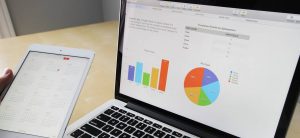Data Visualization as a Form of Sculpting

Image Source: Lukas | Pexels
“If communication is more art than science, then it’s more sculpture than painting. While you’re adding to build your picture in painting, you’re chipping away at sculpting. And when you’re deciding on the insights to use, you’re chipping away everything you have to reveal the core key insights that will best achieve your purpose,” according to Craig Smith, McKinsey & Company’s client communication expert.
The same principle applies in the context of data visualization. Chipping away is important to not overdress data with complicated graphs, special effects, and excess colors. Data presentations with too many elements can confuse and overwhelm the audience.
Keep in mind that data must convey information. Allow data visualization elements to communicate and not to serve as a decoration. The simpler it is, the more accessible and understandable it is. “Less is more” as long as the visuals still convey the intended message.
Finding the parallel processes of exploratory and explanatory data visualization and the practice of sculpting could help improve how data visualization is done. How can chipping away truly add more clarity to data visualization?
Exploratory Visualization: Adding Lumps of Clay
Exploratory visualization is the phase where you are trying to understand the data yourself before deciding what interesting insights it might hold in its depths. You can hunt and polish these insights in the later stage before presenting them to your audience.
In this stage, you might end up creating maybe a hundred charts. You may create some of them to get a better sense of the statistical description of the data: means, medians, maximum and minimum values, and many more.
You can also recognize in exploratory if there are any interesting outliers and experience a few things to test relationships between different values. Out of the 100 hypotheses that you visually analyze to figure your way through the data in your hands, you may end up settling on two of them to work on and present to your audience.
In the parallel world of sculpting, artists do a similar thing. They start with an armature-like raw data in designing. Then, they continue to add up lumps of clay on it in exploratory visualizations.
Artists know for sure that a lot of this clay will end up out of the final sculpture. But they are aware that this accumulation of material is essential because it starts giving them a sense of ideal materialization. Also, adding enough material will ensure that they have plenty to work with when they begin shaping up their work.
In the exploratory stage, approaching data visualization as a form of sculpting may remind us to resist two common and fatal urges:- The urge to rush into the explanatory stage – Heading to the chipping away stage too early will lead to flawed results.
- The urge to show all of what has been done in the exploratory stage to the audience, begrudging all the effort that we have put into it – When you feel that urge, remember that you don’t want to show your audience that big lump of clay; you want to show a beautified result.
Explanatory Visualization: Chipping Away the Unnecessary
Explanatory visualization is where you settle on the worth-reporting insights. You start polishing the visualizations to do what they are supposed to do, which is explaining or conveying the meaning at a glance.
The main goal of this stage is to ensure that there are no distractions in your visualization. Also, this stage makes sure that there are no unnecessary lumps of clay that hide the intended meaning or the envisioned shape.
In the explanatory stage, sculptors use various tools. But what they aim for is the same. They first begin furtherly shaping the basic form by taking away large amounts of material. It is to ensure they are on track. Then, they move to finer forming using more precise tools to carve in the shape features and others to add texture. The main question driving this stage for sculptors is, what uncovers the envisioned shape underneath?
In data visualization, you can try taking out each element in your visualization like titles, legends, labels, colors, and so on. Then, ask yourself the same question each time, does the visualization still convey its meaning?
If yes, keep that element out. If not, try to figure out what is missing and think of less distracting alternatives, if any. For example, do you have multiple categories that you need to name? Try using labels attached to data points instead of separate legends.
There are a lot of things that you can always take away to make your visualization less distracting and more oriented towards your goal. But to make the chipping away stage simpler, C there are five main things to consider according to Cole Nussbaumer Knaflic as cited in her well-known book, Storytelling with Data:- De-emphasize the chart title; to not drive more attention than it deserves
- Remove chart border and gridlines
- Send the x- and y-axis lines and labels to the background (Plus tip from me: Also consider completely taking them out)
- Remove the variance in colors between the various data points
- Label the data points directly
In the explanatory stage, approaching data visualization as a form of sculpting may remind us of how vital it is to keep chipping away the unnecessary parts to uncover what’s beneath, that what you intend to convey is not perfectly visible until you shape it up.
Overall, approaching data visualization as a form of sculpting may remind us of the true sole purpose of the practice and crystalize design in the best possible form.
Sign up for The KPI Institute’s Certified Data Visualization Professional course to learn the fundamentals of creating visual representations, the most effective layouts, channel selection, and reporting best practices.


 In 2017, the Performance Magazine editorial team interviewed Francesco Consolati, Advisory Business Solution Manager – Risk, Fraud and Performance Management at SAS – Italy. His thoughts and views on Performance Management are detailed below.
In 2017, the Performance Magazine editorial team interviewed Francesco Consolati, Advisory Business Solution Manager – Risk, Fraud and Performance Management at SAS – Italy. His thoughts and views on Performance Management are detailed below.
